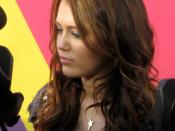Sarah Folks
COM 470
12/3/2013
Turn-Taking in a Casual Conversation
Although a conversation with an acquaintance often feels as effortless as breathing, the way in which we manage taking turns is fairly structured and frequently follows a predictable pattern. I've noticed, through conversation analysis of two different types of conversations, that individuals who appear to be familiar with each other use certain conversation techniques more frequently than others to effectively manage the turn-taking process. This paper will examine more thoroughly the ways in which individuals in an informal conversation control the turn-taking process by using particular discourse markers and response tokens intermittently through out the chatter. That is, in analyzing two different casual conversations between acquaintances, certain words and phrases were used in abundance to execute the conversation's turn-taking.
My data consists of a recent talk show interview between Alan Carr and Miley Cyrus, as well as a video recording of two girls gossiping about the TV-turned-pop star.
By analyzing these two sets of data, I've concluded that individuals participating in naturally occurring speech as well as in a public mediated conversation predominantly use a variety of conversational functions such as discourse markers as response tokens to regulate the turn-taking process throughout a casual conversation. My data will be analyzed through an approach to discourse analysis called Conversation Analysis and will suggest that individuals who appear to be familiar with each other will use certain tools to locally manage the conversation and control the conversation's turn-taking through the use of certain discourse markers and response tokens to infer agreement or disagreement.
Background and Methods
The method I chose for this analysis paper is formally titled Conversation Analysis. It's main idea, that "utterances are used to do things; perform actions," was pioneered in the late sixties by Harvey Sacks and...


